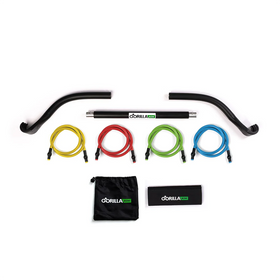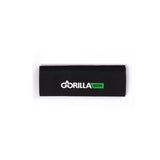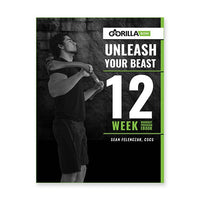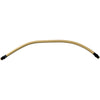Best Pull-Up Alternatives: 9 Exercises for a Strong, Defined Back

The pull-up is one of those exercises that makes you feel like a true athlete. It’s also one of the best upper body movements using just your body weight. However, to do pull-ups, you must go to a gym or have a pull-up bar installed in your home. Plus, if you’re not yet able to do a full pull-up, you’ll need a machine or bands to remove some of your weight.
Thankfully, several pull-up alternatives effectively work the same muscle group. These movements are also easier to do, meaning you can gradually build up your strength, then try pull-ups later if you wish.
First Thing’s First: What Is a Pull-up?
The pull-up is an upper body strength exercise. Traditionally, you perform it hanging from a pull-up bar with your palms facing away from you. Using your back and arm muscles, you pull yourself up until your chin is above the bar.
Pull-ups are some of the most challenging bodyweight exercises, and many people struggle just to perform one. It takes a lot of strength to pull your own weight that high, so you’ll typically need to start with assistance or alternative exercises.
Pull-up alternatives strengthen the same muscles as pull-ups while also helping you build strength gradually if your goal is to perform a full pull-up eventually.
What Muscles Do Pull-Ups Work?
Pull-ups are fantastic for strengthening your back muscles. They work the following muscles at one time:
Pull-ups also engage several secondary and stabilizer muscles, such as the rear deltoid (the muscle on the back of your shoulders) that help you pull your shoulders back and down during the pull-up.
Benefits of Pull-Ups
The most important benefit of the pull-up is building a strong, defined back. Pull-ups help men and women build powerful back muscles that look great on any frame.
Pull-ups also help you increase your endurance and grip strength. In addition, they work many important muscles at once while upgrading your strength training workouts.
Pull-Up Alternatives: What Exercises Can You Do Instead of Pull-Ups?
Pull-ups aren’t the only way to strengthen and tone your back muscles. The following alternatives work great, especially if you don’t have access to a gym or prefer to do your workouts at home.
If you’re following a workout plan that calls for pull-ups, these alternatives can typically work in place of the pull-ups. You can also mix them up to provide variety in your routine.
1. Bent-Over Rows
There are many ways to perform a rowing exercise, and bent-over rows are one of the most popular options. You can do these with a bar, dumbbells, or resistance bands (see a tutorial for bent-over rows with the Gorilla Bow here).
How to do them:
- Bend your knees slightly as you hinge your hips back with your torso over the bar or dumbbells. Keep your back neutral throughout the movement.
- Use an underhand grip if using a bar. Keep your hands shoulder-width apart.
- While staying bent over, pull the weight up towards your upper abs as you contract your back muscles.
- Lower the weight slowly to the starting position. That’s one rep.
2. Seated Rows
Seated rows are an alternative to the pull-up and bent-over rows. The most traditional way to do this is with a seated cable machine, but you can also do a seated row anywhere with the Gorilla Bow or other resistance bands.
How to do them:
- Grab the handle, keeping your arms close next to each side of your torso throughout the movement.
- Pull the weight toward your lower abdomen, focusing on using the muscles of your upper back and arms rather than using momentum from moving your torso.
- Squeeze your shoulder blades together and keep your back straight, targeting your mid-to-upper back.
- Extend your arms to return to starting. That’s one rep.
3. Kneeling Lat Pulldowns with Resistance Bands
You can do seated lat pulldowns with machines at the gym, but there are ways to do it machine-free, too. By anchoring a Gorilla Bow above you, you can perform the move while kneeling on the ground.
How to do them:
- Hang your band on a high-sturdy location, such as a tree, shelf, or pole, about 3-4 feet from the top of your head.
- Kneel on the ground a little behind and at an angle from where the band is hanging.
- Grab the Gorilla Bow bar with a wide grip. Contracting your lat muscles, bend your arms to pull the bar towards your chest while puffing out your chest.
- Straight your arms to return the bar to standing. That’s one rep.
4. Straight-Arm Pulldowns
You can also do straight-arm lat pulldowns using a resistance band at home. By keeping your arms straight during the movement, you’ll also engage your abs more while working the lats.
How to do them:
- Anchor the band to a high, sturdy location, such as a door anchor, shelf, tree, or pole.
- Attach a Gorilla Bow or handles to the end of the band.
- Kneel on the ground a little behind and at an angle from where the band is hanging.
- Start with your arms straight in front of you at about neck height with your chest up and head straight.
- Bring your arms straight down to push behind you, making sure you feel your back muscles working. Keep your arms straight the entire time.
- Return your arms up to the starting position. That’s one rep.
5. Dumbbell Pull-Overs
Dumbbell pull-overs work best if you have dumbbells (duh) and a bench. You’ll work your lats and chest with this great alternative to pull-ups.
How to do them:
- Start by sitting on the end of the weight bench with your feet flat on the floor and a dumbbell in each hand.
- Lie back so that the bench supports your head, neck, and back.
- While holding the dumbbells, extend your arms up over your chest with your palms facing each other, elbows bent slightly.
- Slowly, bring the weights back behind your head, keeping your arms straight with slightly bent elbows. Your arms should extend until they’re in line with your head and body.
- Bring the weights back up above your chest to the starting position. That’s one rep.
6. Renegade Rows
Renegade rows can be performed with just a mat and some dumbbells. It’s also a good lat workout for engaging your glutes and arms simultaneously.
How to do them:
- Start in a plank position on a workout mat with a dumbbell under each hand, and your feet positioned just outside the mat width.
- Keeping your hips and shoulders down, bend your elbow to pull one of the dumbbells up towards your torso and past your hip, rowing through your back.
- Bring the dumbbell back to the starting position, then repeat with the other side, staying in the plank the entire time. That’s one rep.
7. One-Arm Rows
One-arm rows allow you to isolate your lats on one side at a time, much like renegade rows. The difference is that you’re using a bench for support instead of having to balance in a plank position.
How to do them:
- Place your right knee and shin on a workout bench. Hold a dumbbell in your left hand while grabbing the front of the bench with your right hand.
- Stand your left leg to the side to keep you stable as you lift the weight. Maintain a neutral neck and spine throughout the movement.
- Keeping your back parallel to the ceiling, bend your left arm to pull the dumbbell up to your armpit, keeping your palm facing your body.
- Bring the weight straight back down, maintaining a slight bend in your elbow. That’s one rep. After completing all reps on one side, be sure to repeat the movement on the other side.
- Alternatively, you can use a Gorilla Bow by placing one foot on the band(s) and pulling the bow with the same-side arm.
8. Resistance Band Pull-Aparts
Pull-aparts are an isolation exercise and scapular retraction movement. They target the muscles throughout your upper back, including the trapezius that is part of your lats, and your shoulders.
Pull-aparts are fantastic for strengthening weak upper back muscles, helping you prepare for more strenuous exercises like pull-ups. They can also help improve your posture and prevent shoulder injuries.
How to do them:
- Start standing, holding a resistance band gripped at shoulder width with your arms straight out in front of you.
- Pull the band out laterally as you extend your arms out to the sides, still keeping your arms straight.
- Squeeze your shoulder blades together hard as you pause for a count. Then, bring your arms back to the starting position in front of your body. That’s one rep.
9. Assisted Pull-Ups with a Resistance Band
If your goal is to do full pull-ups, but you don’t have the strength yet, assisted pull-ups are the ideal exercise. They remove some of your body weight through machine or band assistance. In this article, we’re covering the band option.
How to do them:
- Loop a resistance band around a pull-up bar so that it’s snug and hanging down.
- Step one foot inside the band. (You might need someone to help you pull the band down far enough to step inside. You can also step on something sturdy so that it’s easier to step into the band.) Bring your other foot lightly on top of the first foot.
- Hang from the bar with your hands gripping the back just outside shoulder width. Pull your shoulders back and down and engage your lats.
- Bend your arms as you lift yourself up to bring your chin to the bar, then lower back down. That’s one rep.
- Adjust the resistance as needed. You should be able to do a full pull-up while still being challenged.
Pull-ups are a goal exercise for many athletes and gym-goers, but they’re certainly not the only option for building strong and defined back muscles. These pull-up alternatives will help you gain back strength and define those muscles that look great in a tank top.
Other Pull-Up Alternatives FAQs
Is a Pull-Up Bar Necessary for a Good Back Workout?
Pull-ups are one of the most effective exercises for building back muscles. However, they’re not mandatory for fantastic workouts and a strong back.
You can do any of these lat workouts instead of pull-ups to gain strength and definition. And as you build that strength, you might get excited to give pull-ups a shot!
If you want to do pull-ups, you will need a pull-up bar or some other equipment sturdy enough to perform pull-ups safely.
Who Should Be Doing Pull-Up Alternatives?
Pull-up alternatives are perfect for anyone who can’t yet do a full pull-up. They’re also excellent when you don’t have access to a gym or pull-up bar and want safe, effective home-based options.
What Is a Pull-Up Alternative for Murph?
The Murph Challenge, also known as the CrossFit Hero WOD (workout of the day) 'Murph', was created to honor LT. Michael P. Murphy (SEAL) who died in Afghanistan in 2005. It’s an intense workout that many CrossFitters complete on Memorial Day.
Murph typically includes 100 pull-ups (along with 200 push-ups and 300 air squats, sandwiched between two separate one-mile runs — whew!). However, if you can’t do pull-ups, you have other options.
Simply replace the pull-ups with something more manageable. Your options include:
- Assisted pull-ups
- Inverted rows
- Pull-downs
- Seated rows
- Kneeling lat pulldowns with resistance bands
As you’ve probably noticed, these Murph pulldown alternatives include most of the exercises we’ve already outlined here.
Also, if the 100 reps are still daunting, you can cut that number in half and work up to doing the complete Murph reps. You’ll feel like a beast in the best way!
How Often Should You Do Pull-Up Alternatives?
For most people, two to three times per week is great for performing alternative pull-up exercises. It’s best to provide 24 to 48 hours of rest in between back workouts so that your muscles have time to rest and rebuild.
Never miss a workout again with at-home exercises, including alternatives to pull-ups and other movements you typically perform at a gym. With the Gorilla Bow and the All-Access membership, you can work out any time, anywhere, with access to expert-led workouts for all fitness levels and workout types. Try it out with seven FREE days of live, on-demand classes here.











Leave a comment